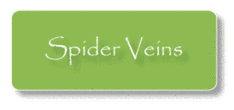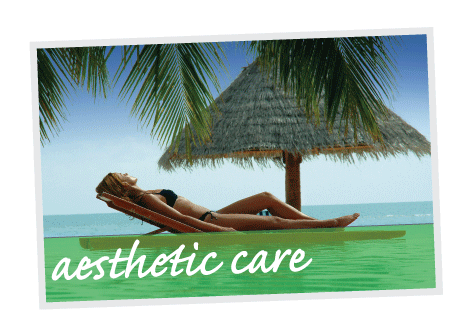
What are Spider Veins?
Spider veins are like varicose veins but smaller. These red, blue or purple lines may develop on any part of the body, including the face, but most often appear on the thighs, calves, or buttocks. The condition is associated with increased pressure to the veins. Approximately one third of the adult female population is troubled with this common problem. Although it is less common, men develop spider veins as well. People often seek treatment for spider veins because of cosmetic concern. However, spider veins can cause symptoms such as aching, burning, swelling, heaviness, itching and night cramps.
Spider veins may be isolated or associated with “feeder” veins. They can also be associated with larger underlying varicose veins.
Certain factors contribute to the development of spider veins, including heredity, pregnancy, hormonal factors, weight gain, occupations or activities that require prolonged sitting or standing, and trauma.
Spider Veins Treatments
Sclerotherapy for Spider Veins
A common form of treatment for spider veins is sclerotherapy. It is a simple and easy procedure designed to permanently remove spider veins leaving your legs looking younger and healthier. This is an in-office procedure where veins are injected with a solution, using tiny needles, which causes them to collapse and fade from view. The procedure typically improves not only the cosmetic appearance but associated symptoms as well. The procedure normally takes 15 to 30 minutes, depending on how many spider veins are treated. This procedure requires no anesthesia and discomfort is minimal. You may need repeated sessions and many injections per session depending on the extent of the spider veins.
Laser Vein Treatment
Laser vein removal is an easy, fast, and effective way to treat superficial veins. Laser therapy has been used in medicine for more than 30 years. Advances in technology have helped developed many different lasers. The laser uses a focused beam of light. The most common laser used to treat spider veins is the Nd: YAG Laser system. It is a hand held device and also has a cooling tip to minimize the discomfort during the therapy. In the treatment of veins, the wavelength of light is targeted to the pigment in the blood. The laser heats up the small vein and destroys it. The laser beam is focused and does not damage the nearby skin tissue. Over a period of four to six weeks, the vein is reabsorbed by the body and disappears.Lasers are especially suited to treat small spider veins when a needle cannot be used.
Spider Veins Frequently Asked Questions (FAQ)
Does insurance cover spider care treatments?
Unfortunately, spider veins are considered cosmetic and the cost of treatment is not covered by any insurance companies.
What are spider veins?
Spider veins are like varicose veins but smaller. They are red, blue or purple thread like veins close to the skin surface. They may develop on any part of the body, including the face, but most often appear on the thighs, calves, or buttocks
What causes spider veins?
The real cause of spider veins is not known but they are more prominent in obese individuals, females, individuals who are on their feet for prolonged periods, minor trauma, pregnancy and perhaps use of contraceptives. There may be a familial component to these veins. In general, any condition that will increase pressure in the veins, can lead to spider veins.
How are spider veins treated?
There are several options in treating spider veins. The most common is sclerotherapy and laser.
How do lasers treat spider veins?
Laser treatment is a safe, effective option for spider veins. Repeat sessions may be required in some cases. The laser bean is attracted by the melanin in the blood and causes it to coagulate and disappear.
How is sclerotherapy done?
Sclerotherapy involves injection of a sterile solution (called a sclerosing solution) into the small veins using a very fine, thin needle. This solution irritates the vein lining causing it to collapse and eventually disappear. Multiple veins can be injected at each session. The sclerosing solution used today is painless, unlike saline solutions used many years ago.
Which is the best treatment for spider veins: LASER TREATMENT OR SCLEROTHERAPY?
Sclerotherapy has been round for 20 years and is a safe procedure. The procedure involves the use of multiple injections to destroy the vein. Lasers on the other hand do not require needles and are currently in vogue. Laser therapy is also slightly more expensive than sclerotherapy. Laser therapy is fast becoming the procedure of choice.
Is there any preparation required before laser treatments or sclerotherapy?
No extensive preparation is required before the procedure. It is recommended that one stop smoking and stop taking aspirin a few day before the procedure. Any patient on a blood thinker is not a candidate for sclerotherapy.
What happens after sclerotherapy treatment?
There is some mild pain which can easily be overcome with Tylenol. The injected site will appear bruised and swollen for a few days. Continual wearing of the ace bandaged will relieved the swelling and pain. The bruising usually disappears in 2-3 weeks. One will have no problem with walking. After the first 2 days, most patients can resume their normal activities.
How long is each sclerotherapy session?
Generally, most individuals have multiple spider veins and only up to 15-20 injections can be done at seating. Each treatment session lasts up to 30 minutes. After the treatment support hose are worn and the leg is wrapped with an ace bandage. The ace bandage is left on until the following day and the hose are worn for at least a week.
When is the best time to have the spider veins treated?
Spider veins have no symptoms and the major problem is cosmetic. Therefore, the surgery is strictly elective and can be done any time. Spider veins do tend to become more prominent during pregnancy and so it is best to wait until the pregnancy is over.
Can spider veins recur?
Although spider veins can develop during subsequent pregnancies, previously treated veins should not reoccur. Spider veins can be removed but new ones can always occur. Most people who have spider veins have a predisposition and despite treatment, new veins will appear in the coming years. There is no cure for spider veins.
How much does Sclerotherapy cost?
Sclerotherapy cost $210. for each 30 minute session. The total length of time needed can only be determined by scheduling a consult with Dr. Daws before treatment.
How much does Laser vein treatments cost?
Laser vein treatments cost $130. for each 15 minute session. The total length of time needed can only be determined by scheduling a consult with Dr. Daws before treatment.
Key Benefits
- Beautiful Legs
- Reduced Swelling
- Reduced Pain
Pricing
- Laser -


 $130 per 15 minutes
$130 per 15 minutes
- Sclerotherapy -
 $210 per 30 minutes
$210 per 30 minutes
- Vnus Closure -

 Depends on insurance contract agreement
Depends on insurance contract agreement
- Support Hose -
 Price depends on style chosen
Price depends on style chosen
Planning Your Treatment
During your initial consultation, your legs will be examined. Your doctor may draw a simple sketch of your legs, mapping out the areas affected by spider veins or other problems. During the examination, you will be checked for signs of more serious "deep vein" problems, often indicated by swelling, sores, or skin changes at the ankle. A hand-held Doppler ultrasound device is sometimes used to detect any backflow within the venous system. This is referred to as reflux.
If such problems are identified, you may be a candidate for the VNUS Closure procedure. This procedure is performed instead of the traditional vein stripping. Problems with the larger veins must be treated first, or sclerotherapy and/or laser treatments of the surface veins will be unsuccessful.
During the initial consultation we will ask you about any other problems you may have with your legs, such as pain, aching, itching or tenderness. You will be asked about your medical history, your family history, medications and conditions that would preclude you from having treatment.
Medical insurance usually covers VNUS Closure for the treatment of varicose veins but does not cover cosmetic procedures such as sclerotherapy and laser treatments.
Preparing For the Procedure
You will receive specific instructions from your physician on how to prepare for your treatment. Carefully following these instructions will help the procedure go more smoothly.
You'll be instructed not to apply any type of moisturizer, sunblock or oil to your legs on the day of your procedure. You may want to bring shorts to wear during the injections, as well as your physician-prescribed support hose, and slacks to wear home.
When scheduling your procedure, keep in mind that your legs may be bruised or slightly discolored for some weeks afterward. You probably won't be comfortable wearing shorts, a swimsuit or mini skirts until after your legs have cleared up a bit.
The Procedure
A typical sclerotherapy session is relatively quick, lasting only about 15 to 45 minutes. After changing into shorts, your legs may be photographed for your medical records. You will be asked to lie down on the examination table and the skin over your spider veins will be cleaned with an antiseptic solution. Using one hand to stretch the skin taut, Dr. Daws will begin injecting the sclerosing agent into the affected veins. Bright, indirect light and magnification help ensure that the process is completed with maximum precision. Pressure is applied to the treated area.
During the procedure, you may want to listen to music, read, or just talk to your practitioner. You will be asked to shift positions a few times during the process. As the procedure continues, you will feel small needle sticks and possibly a mild burning sensation. However, the needle used is so thin and the sclerosing solution is so mild that pain is usually minimal.
After Your Treatment
In addition to an ace bandage, tight-fitting support hose may be prescribed to guard against blood clots and to promote healing. The ace bandage can be removed after 48 hours. However, you should wear the support hose for 72 hours or more.
It's not uncommon to experience some cramping in the legs for the first day or two after the injections. This temporary problem usually doesn't require medication.
You should be aware that your treated veins will look worse before they begin to look better. When the compression dressings are removed, you will notice bruising and reddish areas at the injection sites. The bruises will diminish within one month. In many cases, there may be some residual brownish pigmentation which may take up to a year to completely fade.
Getting Back to Normal
Although you probably won't want to wear any leg-baring fashions for a few weeks, your activity will not be significantly limited in any other way from sclerotherapy treatment.
You will be encouraged to walk to prevent clots from forming in the deep veins of the legs. However, during the period of time to complete your treatment program, prolonged sitting and standing should be avoided, as should squatting, heavy weight lifting and "pounding" type exercises, including jogging.
A one-month healing interval must pass before you may have your second series of injections in the same site. After each treatment, you will notice further improvement of your legs' appearance.
Your New Look
Most patients are pleased with the difference sclerotherapy makes. The skin of your legs will appear younger, clearer and more healthy-looking. If you've been wearing long skirts and slacks to hide your spider veins, you'll now be able to broaden your fashion horizons. Often, patients are surprised at the dramatic difference in appearance between a treated leg and an untreated one.
Although sclerotherapy will obliterate the noticeable veins for good, it's important to remember that treatment will not prevent new spider veins from emerging in the future. As time passes, you may find that you need "touch-ups" or full treatments for new veins that surface. But even if you choose not to have further sclerotherapy, your legs will look better than if you never had treatment at all.
BEFORE
AFTER















